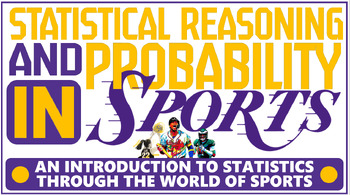Sports Statistics & Probability curriculum workbook (130+ pages) - Project-based
- PDF
Description
WATCH THE PREVIEW CLIP! E-MAIL ME FOR DISCOUNTS OR QUESTIONS AT MEDEIROSVINNY@YAHOO.COM.
Looking to start an elective math class?
Interested in project-based assessments?
Tired of teaching statistics with no real-world application?
This 132-page interactive workbook serves as a textbook for an introductory statistics math class; complete with Common Core standards crosswalk, embedded answers, and tons of activities and mini-projects. This workbook is the only resource I use for my 'Statistical Reasoning and Statistics in Sports' class, with 12 sections of statistical concepts intertwined with the world of sports. The pages are loaded with gifs, data, and relevant information...updated as of June 2024.
This is a completely customized workbook/textbook for teachers looking for a more engaging and student-based approach to teaching statistical concepts through the realm of sports...including team sports, individual sports, video games, WWE and much more. There are 12 sections, each one containing relevant activities, traditional assessments, and mini-projects. The workbook is sold as PDFs (with answers attached in the back) but you will receive the PowerPoint with it, which includes embedded answers and interactive gifs. Basically, everything you need is provided including rubrics and exemplars for all projects. There are over 25 assessments, mixing traditional question-answer responses with mini-projects where students have a role in choosing how to show their level of understanding.
The 12 sections to the workbook were hand-picked for their application and relevance to the world of sports:
- Visual Data - Creating and analyzing the different charts and graphs that we encounter on a daily basis; digging into the story behind the numbers
- Research - Finding and presenting relevant data to defend an opinion or choice; deciphering bad data from good data
- Central Tendency - Calculating and analyzing the mean, median, mode, and range; creating and interpreting box-and-whisker plots and bell curves
- Z-scores - Comparing player statistics across different eras and sports
- Scatterplots - Determining correlation strength between two variables; using technology to find correlation coefficients and line of regression
- Probability - Reading tree diagrams and frequency tables to determine the likelihood of events happening; calculating compound probability in order to make decisions and determine likely outcomes
- Analytics - Discussing the analytic and sabermetric overhaul of how the game is played and coached; calculating and applying Pythagorean Expectation to determine both current and historic team winning potential
- Simulations - Creating and exploring simulation dot plots to determine realistic outcomes; analyzing computer-generated simulations to problem solve and highlight abnormalities
- Combinations/Permutations - Exploring possible outcome groupings through appropriate formula usage and calculations
- Franchise Creation - Building an entire NBA franchise from the ground up; embedding curriculum into a large-scale project
- Sports Management & Marketing - Applying research and school-based skills to real-world situations; transforming data into career success
- Running an Experiment - Developing and coordinating all aspects of a self-directed study; forming conclusions based on data collection and analysis
INCLUDED PROJECTS:
Creating and marketing a new Jordan shoe
Highest selling video games of all-time graph
Custom infographic
Custom scatterplot with correlation coefficient and line of regression
GOAT debate
Team relocation and rebranding with demographics
All-time team box-and-whisker plot
Player statistics bell curve
High school conference realignment through z-scores
UConn Men's and Women's tree diagram comparison
NFL Draft order with Pythagorean Expectation
Favorite team with Pythagorean Expectation
NFL Fantasy quarterback with simulations
NBA Draft order with combinations/permutations
Using statistics to negotiate player contracts
Rebranding your high school athletic program
Operating the finances of an outdoor stadium (interactive Google Sheet)
Using fan feedback to address (and remedy) issues within MLS and MLB
Creating a sports-related business
Running an experiment with class as test subjects or researching online
NBA Franchise Project - Students use all of the topics covered in the workbook to create a new NBA franchise from scratch. Students choose the players, name the team, develop logos and uniforms, then create visual displays of data based on their decisions.
*Fantasy football and basketball leagues (optional)
If you purchase this item, be sure to send me an e-mail and I can send you extra resources and alternate versions of the workbook for FREE. The slide formatting can sometimes be a little off depending on what version of PowerPoint you open the files with, simply contact me for an easy fix.





